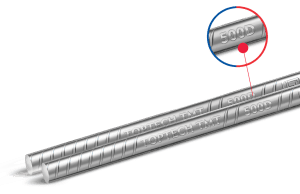We all strive for the best quality materials while building our homes, but little do we know about how to choose the good quality materials. The quality determinant factor for the elementary building materials like the steel TMT bar precisely depends upon its quality gradation. Such quality gradations are primarily divided in three categories: Fe 415, Fe 500 and Fe 500D.
Concrete mixture is considered to be the best binding compound for construction; however its ability to withstand higher tensile load is quite low, thus it needs to be reinforced through steel TMT bars to make it a corrosion resistant structure. Thus, a good quality TMT bar plays an elementary role in making the RCC structure stronger and more stable to endure external loads and hazards.
It first started with plain steel bars, evolved through deformed pained rebar to cold twisted steel bar. Presently the market is dominated by steel TMT bars that are manufactured with first class iron ore and processed through thermo-mechanical treatment, using tungsten carbide rollers. Generally people tend to opt for TMT bars with higher specified grade; however one must remember that each construction type has its own requirements to fortify the structure with great strength and ductility.
Modern construction experts give greater emphasis on the safety of an RCC structure, which is dependant the ductile strength of the structure, more specifically upon the reinforcement steel rebar. Thus they use modern limit state method for detailing. Generally the types of loads taken into consideration are the live load, dead load, wind load and earthquake load etc. and their combinations. Both material strength and acting load are given thorough attention while designing any RCC structure.
Design load = Characteristic load x practical safety factor for load
Thus they tend to use Fe 500 grade which in turn ensures ductile strength and reduces the steel volume and column size as well. Whereas Fe 415 steel rebar requires greater number of TMT bars to endow with the required strength, consequently increase the number and size of columns. This becomes a serious issue where space is an elementary concern, especially in case of high rises.
 The quality grade of steel for both Fe500 and 500D is same; it is 500N/mm2. However the difference lies in the higher ductile strength in 500D grade TMT bars. ‘500’ here refers to the  consistency in strength and ‘D’ denotes the ductility of steel rebar. This enables the TMT bars to hold up to the unexpected load absorption ability, which is mostly encountered during earthquakes and other calamities.
The quality grade of steel for both Fe500 and 500D is same; it is 500N/mm2. However the difference lies in the higher ductile strength in 500D grade TMT bars. ‘500’ here refers to the  consistency in strength and ‘D’ denotes the ductility of steel rebar. This enables the TMT bars to hold up to the unexpected load absorption ability, which is mostly encountered during earthquakes and other calamities.
Another point to be noted that good quality 500 D rebar is at par with the latest standards set by Bureau of Indian Standards (BIS).
Comparison showing Mechanical properties of ordinary TMT Bars with good quality 500D TMT Bars
| Standard Fe 500 | Good Quality 500D | |
| Yield Stress | 500 | 520 min |
| Ultimate Tensile Strength | 545 n/mm2 | 620 N/mm2 |
| Elongation %, Min | 12 | 20 |
Comparison showing Chemical properties of ordinary TMT Bars with good quality 500D TMT Bars
| Standard Fe 500 | Good Quality 500D | |
| Carbon | 0.30 | 0.20 |
| Sulphur | 0.055 | 0.035 |
| Phosphorus | 0.055 | 0.035 |
Some common construction benefits of using the Fe 500D grade TMT bars are:
- Balances the ductility and tensile strength
- Makes it easily bendable and weldable
- Higher seismic resistant design
TMT bars presently used in India are mainly Fe 500D grade. They are well surpassed the minimum limit of strength and ductility specified in the standard IS : 1786, ensuring the quality of steel TMT bars.
You may always ask for ‘Test Certificate’ of your ‘Rebar Purchase’ and compare the data given in this content, to choose which particular grade of TMT bars is suitable for your Dream Home.







